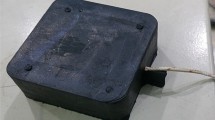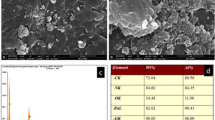Abstract
Styrene butadiene rubber-organoclay nanocomposites were prepared with Cloisite 15A via melt intercalation. X-ray diffraction and transmission electron microscopy indicated that the nanostructures are partially exfoliated and intercalated. The nanocomposites exhibited great improvements in tensile strength and tensile modulus. The incorporation of organoclay gave rise to considerable reduction of tan delta and increase in storage modulus in the rubbery region. It is shown that after 6 phr (parts per hundred rubber) clay loading there is not much increase in the properties. The effect of carbon black (N330) on mechanical properties, dynamic mechanical properties, heat build up, abrasion resistance in the nanocomposites having the optimized clay level (6 phr) was investigated. Optimum results were obtained with the addition of 25 phr carbon black. For comparison with the 6phr nanoclay and 25phr N330 (high abrasion furnace carbon black) filled SBR composites, 40 phr N330 filled SBR composites was used. The 6phr organoclay and 25phr N330 filled SBR nanocomposite showed better properties than 40phr carbon filled SBR compound. These results indicate that 6phr organoclay can be replaced by 15 phr carbon black from the conventional SBR-carbon black based tire tread compounds. The Dynamic mechanical analyzer (DMA) results revealed that the new tire tread compound gives better rolling resistance and comparable wet grip resistance and lower heat build up than that of conventional tread compound.







Similar content being viewed by others
References
Alexandre M, Dubois P (2000) Polymer-layered silicate nanocomposites: preparation, properties and uses of a new class of materials. Mater Sci Eng: R 28:1–63
Strawhecker KE, Manias E (2000) Structure and properties of poly(vinyl alcohol)/Na+ montmorillonite nanocomposites. Chem Mater 12:2943–2949
Gilman JW, Jackson CL, Morgan AB, Harris R, Manias E, Gianeelis EP, Wuthenow M, Hilton D, Phillip SH (2000) Flammability properties of polymer—layered-silicate nanocomposites. polypropylene and polystyrene nanocomposites. Chem Mater 12:1866–1873
Jinghe W, Lerner MM (1993) Structural, thermal, and electrical characterization of layered nanocomposites derived from sodium-montmorillonite and polyethers. Chem Mater 5:835–838
Sridhar V, Tripathy DK (2006) Barrier properties of chlorobutyl nanoclay composites. J Appl Polym Sci 101:3630–3637
Patel S, Bandopadhyay A, Ganguly A, Bhowmick AK (2006) Synthesis and properties of nanocomposite adhesives. J Adhes Sci Technol 20:371–385
Bhowmick AK, Ganguly A, Maiti M (2006) Factors influencing the morphology and the properties of clay-rubber nanocomposites. Kautsch Gummi Kunstst 59:437–446
Karger-Kocsis J, Wu CM (2004) Thermoset rubber/layered silicate nanocomposites. Status and future trends. J Polym Eng Sci 44:1083–1093
Giannelis EP (1996) Polymer layered silicate nanocomposites. Adv Mater 8:29–35
Lietz S, Sandler JKW, Bosch E, Alstadt V (2006) Effect of organoclay structure. Kautsch Gummi Kunstst 7:388–395
Brydson JA (1988) Rubbery Materials and their compounds. Springer, USA
Patel S, Bandopadhyay A, Vjijayabhaskar V, Bhowmick AK (2006) Preparation and properties of new in-situ acrylic copolymer/terpolymer- clay hybrid nanocomposites. Rubber Chem Technol 79:820–834
Vaia RA, Ishii H, Giannelis EP (1993) Synthesis and properties of two-dimensional nanostructures by direct intercalation of polymer melts in layered silicates. Chem Mater 5:1694–1696
Wu Y, Ma Y, Wang Y, Zhang L (2004) Effects of characteristics of rubber, mixing and vulcanization on the structure and properties of rubber/clay nanocomposites by melt blending. Macromol Mater Eng 289:890–894
Zhang L, Wang Y, Wang Y, Sui Y, Yu D (2000) Morphology and mechanical properties of clay/styrene-butadiene rubber nanocomposites. J Appl Polym Sci 78:1873–1878
Sridhar V, Choudhary RNP, Tripathy DK (2006) Effect of fillers on the relaxation behavior of chlorobutyl vulcanizates. J Appl Polym Sci 100:3161–3173
Maiti M, Sadhu S, Bhowmick AK (2005) Effect of carbon black on properties of rubber nanocomposites. J Appl Polym Sci 96:443–451
Vu YT, Mark JE, Pham H, Engelhardt M (2001) Clay nanolayer reinforcement of cis-1, 4-polyisoprene and epoxidized natural rubber. J Appl Polym Sci 82:1391–1403
Chen Z, Gong K (2002) Preparation and dynamic mechanical properties of poly(styrene-b-butadiene)-modified clay nanocomposites. J Appl Polym Sci 84:1499–1503
Ramier J, Gauthier C, Chazeau L, Stelandre L, Guy L (2006) Payne effect in silica-filled styrene–butadiene rubber: influence of surface treatment. J Polym Sci B 45:286–298
Author information
Authors and Affiliations
Corresponding author
Rights and permissions
About this article
Cite this article
Ayippadath Gopi, J., Patel, S.K., Chandra, A.K. et al. SBR-clay-carbon black hybrid nanocomposites for tire tread application. J Polym Res 18, 1625–1634 (2011). https://doi.org/10.1007/s10965-011-9567-9
Received:
Accepted:
Published:
Issue Date:
DOI: https://doi.org/10.1007/s10965-011-9567-9




